[数据结构]Treap简介
[写在前面的话]
如果想学Treap,请先了解BST和BST的旋转
二叉搜索树(BST)(百度百科):[here]
英文好的读者可以戳这里(维基百科)
自己的博客:关于旋转(很水,顶多就算是了解怎么旋转,建议自行上百度)[here]
Treap(= binary search Tree + Heap),中文通常译作树堆,为每个节点附加一个优先值,让优先值满足堆的性质,防止BST退化成一条链。
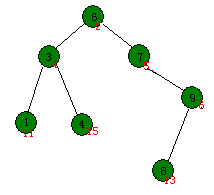
[节点定义]
每个节点像下面这样定义:
1 template<typename T> 2 class TreapNode{ 3 public: 4 T data; //数据 5 int r; //(随机)优先级,用于满足堆的性质,防止退化成链 6 TreapNode* next[2]; //两颗子树,0为左子树,1为右子树 7 TreapNode* father; //父节点,可选 8 TreapNode(T data, int r, TreapNode* father):data(data), r(r), father(father){ 9 memset(next, 0, sizeof(next)); 10 } 11 inline int cmp(T d){ //比较函数 12 if(d > data) return 1; 13 return 0; 14 } 15 };
[旋转操作]
如果像之前那张博客那样打旋转操作,那么到Splay的伸展函数的时候只能笑了。
1 static void rotate(TreapNode<T>*& node, int d){ 2 TreapNode<T>* newRoot = node->next[d ^ 1]; 3 newRoot->father = node->father; 4 node->next[d ^ 1] = newRoot->next[d]; 5 node->father = newRoot; 6 newRoot->next[d] = node; 7 if(node->next[d ^ 1] != NULL) node->next[d ^ 1]->father = node; 8 if(newRoot->father != NULL) newRoot->father->next[newRoot->father->cmp(newRoot->data)] = newRoot; 9 }
这里用d来表示旋转的方向。这样就不至于在旋转的时候后需要用一次if else
其实这里的father可以说用不到,只不过删除操作的时候需要把查找加到一起。
[插入操作]
插入操作时首先按照BST的插入方式进行插入,然后很快就会发现破坏了Heap的性质,比如说上面那张图插入了一个键值为10,优先级为4的节点,按照这个方法,会形成下图这种情形:
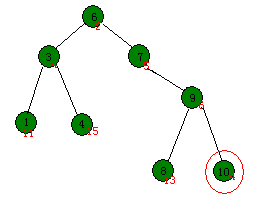
新插入的节点破坏了Heap的性质,那么只能同一种只会改变节点的位置,却不破坏BST的性质的方法来维护——旋转。
为了不制造更多的麻烦(就是通过旋转使其他节点破坏堆的性质),所以应该比父节点更小的那个节点以相反的方向(“有问题的节点”是它的右子树则左旋,否则右旋)旋转到“当前位置”。如下图:
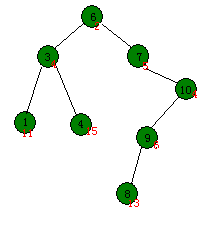
最后经过调整,它满足了堆的性质:

下面是关于插入的完整代码:
1 //实际过程 2 static boolean insert(TreapNode<T>*& node, TreapNode<T>* father, T data, int d){ 3 if(node == NULL){ 4 node = new TreapNode<T>(data, rand(), father); 5 if(father != NULL) father->next[d] = node; 6 return true; 7 } 8 int d1 = node->cmp(data); 9 if(node->data == data) return false; 10 boolean res = insert(node->next[d1], node, data, d1); 11 if(node->next[d1]->r > node->r){ 12 rotate(node, d1 ^ 1); 13 } 14 return res; 15 } 16 17 //用户调用 18 boolean insert(T& data){ 19 boolean res = insert(root, NULL, data, 0); 20 while(root->father != NULL) root = root->father; 21 return res; 22 }
[查找操作]
查找就根据BST的性质进行二分查找就可以了。
1 //实际过程 2 static TreapNode<T>* find(TreapNode<T>*& node, T data){ 3 if(node == NULL || node->data == data) return node; 4 return find(node->next[node->cmp(data)], data); 5 } 6 7 //用户调用 8 TreapNode<T>* find(T data){ 9 return find(root, data); 10 } 11 12 boolean count(T data){ 13 return (find(root, data) != NULL); 14 }
[删除操作]
Treap的删除首先是要找到这个节点。可以试试下面这种情况(删除键值为3的节点):
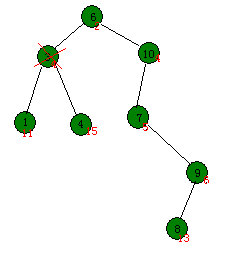
是不是看着怪怪的?那换个简单的,就把键值为9的节点删掉,维护很简单,直接用它唯一的子树来代替它的位置。
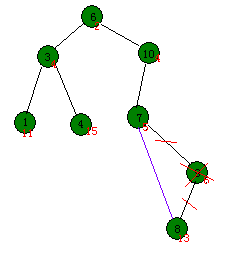
那么再来思考刚刚的问题,删掉键值为3的节点。既然当要删的节点只有一棵子树(或者没有子树)时特别简单,那么反正这个节点也是要删的,暂时破坏一下堆的性质,把它旋转到能够使它只有一个子树的时候,再把它删掉。为了不制造更多的麻烦(就在旋转时,让除去这个节点其他的节点破坏堆的性质),所以应该把更小的那一个子树旋转上来。如下图:

下面是删除操作的代码。
1 //实际过程 2 static void remove(TreapNode<T>*& node, TreapNode<T>*& root){ 3 int direc = ((node->father != NULL) ? (node->father->cmp(node->data)) : (-1)); 4 if(node->next[0] == NULL && node->next[1] == NULL){ 5 if(direc != -1) node->father->next[direc] = NULL; 6 else root = NULL; 7 delete node; 8 }else if(node->next[0] == NULL || node->next[1] == NULL){ 9 TreapNode<T>* stick = (node->next[0] == NULL) ? (node->next[1]) : (node->next[0]); 10 if(direc == -1){ 11 root = stick; 12 stick->father = NULL; 13 }else{ 14 node->father->next[direc] = stick; 15 stick->father = node->father; 16 } 17 delete node; 18 }else{ 19 if(node->next[0]->r < node->next[1]->r) rotate(node, 1); 20 else rotate(node, 0); 21 while(root->father != NULL) root = root->father; 22 remove(node, root); 23 } 24 } 25 26 //用户调用 27 boolean remove(T data){ 28 TreapNode<T>* node = find(data); 29 if(node == NULL) return false; 30 remove(node, root); 31 return true; 32 }
这个代码真的写得不简洁,但是还是要注意下面这几个事项:
- 删除要改变父节点还有子节点的指针
- 旋转的方向
- 记得释放节点占用的内存(如果不是单个文件多组数据输入,其实一般也不会超内存)
[其它操作]
·lower_bound(T data)
还是来看刚刚那棵树,这次我们执行lower_bound(5),很明显,这里结果是6。
首先从根节点开始访问(这不是废话吗),如果遇到相等的或者NULL就可以return了(这有用吗?)
仍然按照和查找一样的方法,以找到和它一样的节点为目标,于是可以得到了如下访问顺序
6 3 4 NULL
看起来被迫得返回了。在返回的过程中,找到的第一个大于它的就是结果,否则不存在。于是得到了6。
下面是代码(至少我认为这个代码还算比较简洁的。。):
1 //实际过程 2 static TreapNode<T>* lower_bound(TreapNode<T>*& node, T val){ 3 if(node == NULL || node->data == val) return node; 4 int to = node->cmp(val); 5 TreapNode<T>* ret = lower_bound(node->next[to], val); 6 return (ret == NULL && node->data > val) ? (node) : (ret); 7 } 8 9 //用户调用 10 TreapNode<T>* lower_bound(T data){ 11 return lower_bound(root, data); 12 }
·upper_bound(T data)
upper_bound和lower_bound差不多,只不过在相等的时候是访问右子树。其它的都是一样的
1 //实际过程 2 static TreapNode<T>* upper_bound(TreapNode<T>*& node, T val){ 3 if(node == NULL) return node; 4 int to = node->cmp(val); 5 if(val == node->data) to = 1; 6 TreapNode<T>* ret = upper_bound(node->next[to], val); 7 return (ret == NULL && node->data > val) ? (node) : (ret); 8 } 9 10 //用户调用 11 TreapNode<T>* upper_bound(T data){ 12 return upper_bound(root, data); 13 }
[完整代码]

1 #include<iostream> 2 #include<fstream> 3 #include<sstream> 4 #include<cstdio> 5 #include<cstdlib> 6 #include<cstring> 7 #include<ctime> 8 #include<cctype> 9 #include<cmath> 10 #include<algorithm> 11 #include<stack> 12 #include<queue> 13 #include<set> 14 #include<map> 15 #include<vector> 16 using namespace std; 17 typedef bool boolean; 18 #define smin(a, b) (a) = min((a), (b)) 19 #define smax(a, b) (a) = max((a), (b)) 20 template<typename T> 21 inline void readInteger(T& u){ 22 char x; 23 int aFlag = 1; 24 while(!isdigit((x = getchar())) && x != -1); 25 if(x == -1){ 26 x = getchar(); 27 aFlag = -1; 28 } 29 for(u = x - '0'; isdigit((x = getchar())); u = (u << 3) + (u << 1) + x - '0'); 30 ungetc(x, stdin); 31 u *= aFlag; 32 } 33 34 template<typename T> 35 class TreapNode{ 36 public: 37 T data; 38 int r; 39 TreapNode* next[2]; 40 TreapNode* father; 41 TreapNode(T data, int r, TreapNode* father):data(data), r(r), father(father){ 42 memset(next, 0, sizeof(next)); 43 } 44 inline int cmp(T d){ 45 if(d > data) return 1; 46 return 0; 47 } 48 }; 49 50 template<typename T> 51 class Treap{ 52 protected: 53 static boolean insert(TreapNode<T>*& node, TreapNode<T>* father, T data, int d){ 54 if(node == NULL){ 55 node = new TreapNode<T>(data, rand(), father); 56 if(father != NULL) father->next[d] = node; 57 return true; 58 } 59 int d1 = node->cmp(data); 60 if(node->data == data) return false; 61 boolean res = insert(node->next[d1], node, data, d1); 62 if(node->next[d1]->r > node->r){ 63 rotate(node, d1 ^ 1); 64 } 65 return res; 66 } 67 68 static TreapNode<T>* find(TreapNode<T>*& node, T data){ 69 if(node == NULL || node->data == data) return node; 70 return find(node->next[node->cmp(data)], data); 71 } 72 73 static void remove(TreapNode<T>*& node, TreapNode<T>*& root){ 74 int direc = ((node->father != NULL) ? (node->father->cmp(node->data)) : (-1)); 75 if(node->next[0] == NULL && node->next[1] == NULL){ 76 if(direc != -1) node->father->next[direc] = NULL; 77 else root = NULL; 78 delete node; 79 }else if(node->next[0] == NULL || node->next[1] == NULL){ 80 TreapNode<T>* stick = (node->next[0] == NULL) ? (node->next[1]) : (node->next[0]); 81 if(direc == -1){ 82 root = stick; 83 stick->father = NULL; 84 }else{ 85 node->father->next[direc] = stick; 86 stick->father = node->father; 87 } 88 delete node; 89 }else{ 90 if(node->next[0]->r < node->next[1]->r) rotate(node, 1); 91 else rotate(node, 0); 92 while(root->father != NULL) root = root->father; 93 remove(node, root); 94 } 95 } 96 97 static TreapNode<T>* lower_bound(TreapNode<T>*& node, T val){ 98 if(node == NULL || node->data == val) return node; 99 int to = node->cmp(val); 100 TreapNode<T>* ret = lower_bound(node->next[to], val); 101 return (ret == NULL && node->data > val) ? (node) : (ret); 102 } 103 104 static TreapNode<T>* upper_bound(TreapNode<T>*& node, T val){ 105 if(node == NULL) return node; 106 int to = node->cmp(val); 107 if(val == node->data) to = 1; 108 TreapNode<T>* ret = upper_bound(node->next[to], val); 109 return (ret == NULL && node->data > val) ? (node) : (ret); 110 } 111 112 public: 113 TreapNode<T> *root; 114 115 boolean insert(T& data){ 116 boolean res = insert(root, NULL, data, 0); 117 while(root->father != NULL) root = root->father; 118 return res; 119 } 120 121 TreapNode<T>* find(T data){ 122 return find(root, data); 123 } 124 125 boolean count(T data){ 126 return (find(root, data) != NULL); 127 } 128 129 boolean remove(T data){ 130 TreapNode<T>* node = find(data); 131 if(node == NULL) return false; 132 remove(node, root); 133 return true; 134 } 135 136 TreapNode<T>* lower_bound(T data){ 137 return lower_bound(root, data); 138 } 139 140 TreapNode<T>* upper_bound(T data){ 141 return upper_bound(root, data); 142 } 143 144 static void rotate(TreapNode<T>*& node, int d){ 145 TreapNode<T>* newRoot = node->next[d ^ 1]; 146 newRoot->father = node->father; 147 node->next[d ^ 1] = newRoot->next[d]; 148 node->father = newRoot; 149 newRoot->next[d] = node; 150 if(node->next[d ^ 1] != NULL) node->next[d ^ 1]->father = node; 151 if(newRoot->father != NULL) newRoot->father->next[newRoot->father->cmp(newRoot->data)] = newRoot; 152 } 153 154 //调试用函数 155 void out(TreapNode<T>* node){ 156 if(node == NULL) return; 157 out(node->next[0]); 158 printf("%d ", node->data); 159 out(node->next[1]); 160 } 161 162 }; 163 164 Treap<int> t; 165 int main(){ 166 srand((unsigned)time(NULL)); 167 freopen("treap.in", "r", stdin); 168 freopen("treap.out", "w", stdout); 169 int n; 170 readInteger(n); 171 for(int i = 1, a; i <= n; i++){ 172 getchar(); 173 char op = getchar(); 174 readInteger(a); 175 if(op == 'I'){ 176 boolean aFlag = t.insert(a); 177 if(aFlag) printf("S\n"); 178 else printf("F\n"); 179 }else if(op == 'D'){ 180 boolean aFlag = t.remove(a); 181 if(aFlag) printf("S\n"); 182 else printf("F\n"); 183 }else if(op == 'L'){ 184 TreapNode<int>* d = t.lower_bound(a); 185 if(d == NULL) printf("NONE\n"); 186 else printf("%d\n", d->data); 187 }else{ 188 TreapNode<int>* d = t.upper_bound(a); 189 if(d == NULL) printf("NONE\n"); 190 else printf("%d\n", d->data); 191 } 192 } 193 // t.out(t.root); 194 return 0; 195 }
[后记]
可以用这份代码和STL的set比比速度,反正在我的电脑上插入、删除都比set快,只有lower_bound和upper_bound稍微比set慢一些。
只不过如果Treap只是做这些的话,直接用set就好了。
于是有了基于普通Treap的数据结构
| 名次树(当然,也可以用其它平衡树实现) | 为Treap的节点附加一个s来统计该子树上的节点总数, 然后旋转、插入、删除的时候维护,就可以来求k小值, 和某个数的排名 |
| 可持久化Treap | 实现可快速分裂合并的序列时,无论是代码量还是速度, 都轻松秒杀Splay |
提供测试数据和题目[here]


 浙公网安备 33010602011771号
浙公网安备 33010602011771号